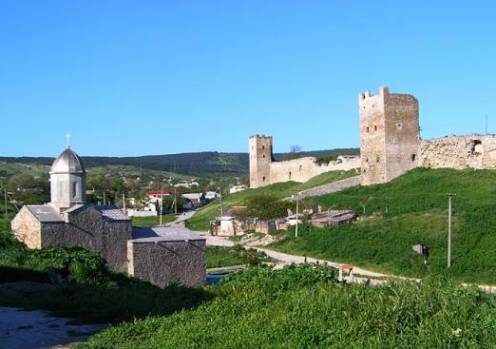

Location: Feodosiya

The Genoese fortress is a medieval fortification in the city of Feodosia (Crimea), built by the Republic of Genoa in the 14th century to defend its largest possession in the Crimea. It is located on the coast of the Feodosia Bay in the southern part of the city. Currently, the historical and architectural reserve "Genoese fortress of Kafa". In the Russian Federation, which controls the disputed territory of Crimea, it is an object of cultural heritage of federal significance; in Ukraine, within the borders of which the disputed territory is recognized by the majority of UN member states, as a monument of cultural heritage of national importance. Unlike other Genoese fortresses of Crimea, it is open around the clock for free, free visits.
The fortress had two lines of fortifications: the citadel and the
outer part. The citadel was built in 1340-1343 around Quarantine
Hill, on steep slopes towards the sea, which could serve as a
primary barrier to enemies, it was completed for another ten years.
In 1343-1346, the Genoese fortress was besieged by Khan Dzhanibek. A
plague spread among the troops of the Golden Horde besieging the
fortress, and the Tatars began to put infected corpses on catapults
and throw them through the fortress walls into the city of Cafu,
which further led to the spread of the plague in Genoa and
throughout Europe.
The citadel was built of marble-like
limestone on lime mortar with carefully worn seams. Building
materials for the fortress were usually mined in places where rocks
came to the surface on the slopes of the surrounding mountains or
from the bottom of the sea. The length of the walls of the citadel
was 718 m, of which 469 m were preserved. The walls reached 11 m in
height and 2 m in thickness. In the middle of the 15th century, out
of 70 thousand inhabitants of Kafa (Feodosia), 45 thousand were
Armenians.
The perimeter of the outer fortifications was
almost 5.5 km and included more than 30 towers. Each tower had its
own name, either by the name of the consul under whom it was built,
or by one of the popes. In plan, the city fortress resembled an
amphitheater, the stage of which was the Feodosiya Bay.
The
citadel housed the consular palace, the treasury, the residence of
the Latin bishop, the courthouse with a balcony for the announcement
of consular decisions, offices for checking weights, warehouses and
shops of especially valuable goods - precious stones, furs, silks.
In the 19th century, most of the buildings were dismantled. The
southern wall of the citadel with two towers (the tower of St.
Clement and the tower of Crisco), part of the western wall, gate
pylons, several towers in different parts of the city (Dock,
Constantine, Thomas, Consul Giovanni di Scaffa) have survived to
this day. On the territory closest to the citadel, a bridge, Turkish
baths and several Armenian churches have also been preserved:
Church of John the Baptist (1348);
Church of St. John the
Evangelist (XIV century);
Church of St. George (XIV century);
Church of St. Stephen (ruins; XIV century).
Church of Saint
Demetrius